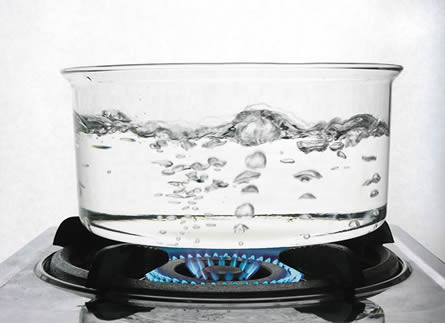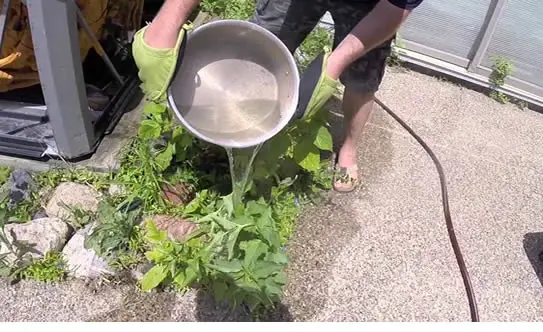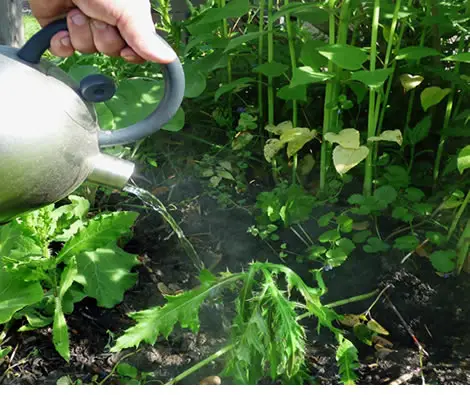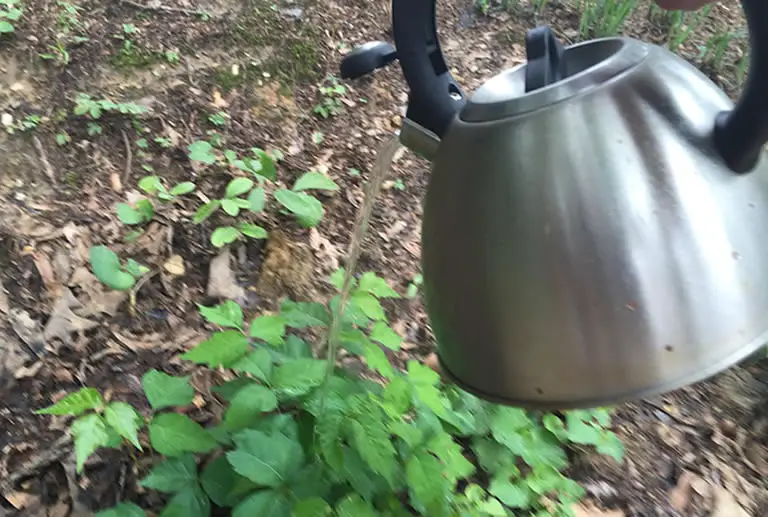Plenty of plant-loving enthusiasts have begun seeking various home remedies and approaches for caring for their greenery, whether as a result of a restrictive budget or out of the motive to provide the best care possible. Although many people habitually boil water before consuming it for safety reasons, is boiled water good for plants?
Table of Contents
Can You Use Boiled Water On Plants?
Boiled water is good for plants as it can benefit them by eradicating risks posed by some chemicals, bacteria, parasites, and harmful living organisms, but boiling cannot reduce the presence of constituents such as metals.
Boiled water should be cooled to room temperature before you use it to water your plants.
 Although using boiled water for your plants can be very beneficial in many cases, it’s vital to understand the ins and outs of using boiled water to reduce the risk of harm and destruction to your precious plant life.
Although using boiled water for your plants can be very beneficial in many cases, it’s vital to understand the ins and outs of using boiled water to reduce the risk of harm and destruction to your precious plant life.
Join us now as we discuss using boiled water for plants, how boiled water can be used for plant life, and the potential outcomes of using water at varying temperatures.
Why cold boiled water is good for plants
So we’ve seen that it is a good idea to used boiled water on both indoor and outdoor plants but is it a good idea to let the water cool before using it?
Is cold boiled water good for both indoor and outdoor plants?
Cold boiled water is very good for plants because the impurities and potential harmful bacteria in the water will have been killed in the boiling process.
However, if you pour boiling water on your plant you run the risk of killing it, so by allowing the water to cool you get all the benefits of boiled water without the risk.
Be aware though that the act of boiling water before using it to care for plants is not related to the heat generated by the process.
In fact water that is at boiling temperature can be very dangerous to your greenery. It is the process of sterilization that occurs when water is boiled that makes boiled water such a good choice for plants.
When water is boiled it eliminates most contaminants such as undesirable impurities and harmful chemicals, which could pose potential risks for your plants’ overall health.
This purification of the water should be your main motive for using boiled water. Boiled water is also great for sterilizing seeds and raising young cuttings.
If you fill a small bowl with lukewarm water and add a little food grade hydrogen peroxide and then steep the seeds in it overnight before planting you will greatly increase your germination count.
Many gardeners and enthusiasts choose to boil water before watering their plants to achieve optimum safety and prevent impurities from being added to the soil and thus diminishing plant health and restricting growth.
Boiled water is particularly beneficial for plants that are more fragile or more sensitive than other species.
*Note: I have read on other websites that using boiling water on your plant is fine as long as you avoid the foliage.
This is the most ridiculous thing I have heard in along time.
Your boiled water must be be cooled to room temperature before it is used on the plant or risk killing it! I will cover this later in the article.
How using boiled water benefits plants
Many misconceptions surround the potential advantages of using boiled water for plants.
Snopes researchers, an online archive team dedicated to debunking urban legends, state that cooled boiled water does not harm plants and will likely be much safer than non-boiled water since most contaminants are eliminated from the liquid via the boiling process.
However, it also found that plants watered with regular water and plants that were watered with boiled water had similar growth rates and overall similar health.
Their investigations are too small to return any real significant data one way or the other and many long-term garden enthusiasts, myself included, will only use boiled, or naturally sanitized water, on seedlings, cuttings and other vulnerable plants.
Having said that other gardening enthusiasts believe that boiling water before giving it to plants is an unnecessary and time-consuming task.
All I can say is test it and see. Do a little split test with the same seeds or cuttings from the same plant.
Use tap water on one set and cleansed boiled water on the others (making sure the boiled water has cooled to at least lukewarm temperature).
If you get better results from using the purified water than you do from using tap water (which I’m betting you will) then you know to continue doing it.
If don’t see any difference from using boiled water and tap water then just use tap water.
But before you opt for the tap water option before testing, let’s take a look at exactly what is in regular tap water.
Is regular tap water ok to use on your plants?
The widespread and primary concern when using regular tap water on plants is the added chlorine it contains.
This chemical is used to assist in the purification of water in order to make it safe for human consumption.
This chlorine additive plays a major role in removing harmful bacteria, germs, parasites, and organisms.
Chlorine, although not majorly harmful to plants in the quantities found in tap water, is something that many die-hard gardeners want to remove from their plants’ water source.
How do you do that?
Well, chlorine can dissipate after sitting in a container of boiled water for around 24 – 48 hours. Add a little O3 sanitizer if you want to avoid water stagnation though it is not completely necessary.
Following this process makes the water safer for plant use than if you took it straight out of the tap.

Chloramine is a completely different kettle of fish!
Chloramine is is a disinfectant compound comprised of chlorine and ammonia that is often added to water to further remove impurities and harmful properties.
Although ammonia is a very beneficial compound found in soil and fertilizer, too much can be toxic to plants and so you want to be able to regulate the amount of ammonia your plants get.
You can’t do that if unspecified amounts are being added through the plants’ water source.
To eliminate chloramine from water you must perform a reverse osmosis technique which can be done by using an active agent to break down its bonds.
Alternatively you can use a chloramines filter. Using such a filter will ensure that the ammonia content is eliminated from the water.
You can either boil the water prior to using this technique or afterwards.
However, be aware that tap water conditions will vary from one area to another, and not all states use chloramine as a water disinfectant so you may not need to go to all this trouble.
Having said that many people state that their tap water supplies contain other constituents, such as iron, manganese, magnesium, and calcareous content, in addition to calcium and sodium, and if these do exist in the tap water supply then be aware that they can kill plant roots.
The process of boiling water does not eliminate or reduce compositions such as metals and may increase their presence since the water is compressed in the process.
Gaining insight into the specific compositions of the tap water in your area is a good idea but may not always be practical or even possible.
Thus, many enthusiasts prefer to boil water to eradicate some chemicals, germs, bacteria, living organisms, and parasites while using other water filtration processes to filter out other harmful agents.
It’s always advised to know the tap water constituents in your area by testing it for pH levels and impurities.
If the tap water in your area houses high levels of any of the above compositions, a good alternative would be to gather water from natural freshwater sources such as accessible running creeks and rivers.
These water supplies do not house as many metals and chemicals as they are generally untreated, but it should definitely be boiled to eliminate parasites and bacteria that will almost certainly be present.
This method may support water use that is freer from chemicals, metals, and harmful living organisms thus giving you plants the healthiest water they could ever need.
The debate over using cold or warm water on plants
While no extreme temperatures are beneficial for plants, warm water is more advantageous than using cold or chilly water.
That is as long as the warm water is in a range of specific temperatures considered lukewarm and is hot or boiling.
Various plant species are not tolerant of cold temperatures, and very cold water can affect them negatively with some reacting worse than others depending on the plant species, the area, and the soil.
Is cold or warm water better for plants?
Neither cold nor warm water is better for plants.
Hot and cold water can have a detrimental effect on the health and growth of many plants.
Plants react best to lukewarm water or water at room temperature.
Pouring icy water directly onto the plant may send it into ‘winter mode’ or it may even freeze its cells this then inhibits the pathways used for water flow and nutrition distribution through the entire plant causing it to dehydrate or even starve.
The same applies to very hot water.
Adding very cold or very hot water to a plant is incredibly detrimental to its health and can greatly inhibit its ability to grow in a healthy manner, especially in climates that are already naturally cool or naturally very hot.
It is always better to lean on the side of caution with your plants by using lukewarm water that is close to room temperature.
This way you are guaranteed to avoid damaging your plants.
The dangers of using boiling water on a plant
While the boiling process is advantageous concerning the water’s compositions and unwanted inclusions, the heat created by the process also poses risks for plants. What happens if you pour boiling water on a plant?
If boiling water is poured on a plant the heat of the water will damage the plant at a cellular level.
The boiling water will scald the foliage and cause destruction to the plant’s cell structure.
The scalding water will also likely reach the roots causing further damage and there is a high chance of hot water killing the plant.
 Although using boiling water can be advantageous when carrying out processes to eradicate weeds, plant diseases, pests, and pathogens organically, as long as you are extremely tentative when applying the water.
Although using boiling water can be advantageous when carrying out processes to eradicate weeds, plant diseases, pests, and pathogens organically, as long as you are extremely tentative when applying the water.
Hot water cannot be used directly onto plants for their safety, but it can be used in surrounding areas for overall care.
Such regions include sidewalk and pavement cracks where weeds may dominate.
Some plants can tolerate heat treatment of temperatures between 120°F – 122°F, which effectively handles various soil-borne pests such as scale, mealybugs, mites, and aphids, as well as various fungal or bacterial pathogens.
The plant’s tolerance will need to be tested before any heat treatment approaches, and the treatment should only be done on soil and roots, as long as the roots do not overheat.
Don’t pour boiling water directly over your plants … ever!
Although boiled water can be beneficial for plant life, plant and garden enthusiasts should always be mindful of appropriate temperatures, tolerance levels of plants being cared for, and the constituents of tap water in the area.
Using boiled water cooled to room temperature is generally safe for plants, and warmer temperatures should never be used for areas of the plant that lie above the roots and soil.
As a safe rule-of-thumb always give a thirsty plant a long drink of boiled water that has been allowed to cool to room temperature.
If you want to be extra safe purify the water further with the use of an appropriate chemical filter and filtration system, like the ones I mentioned, and you can’t go wrong.

